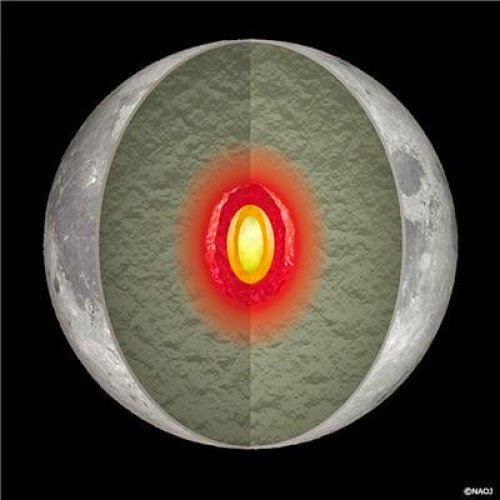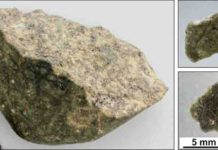
An international research team, led by Dr. Yuji Harada from Planetary Science institute, China University of Geosciences, has found that there is an extremely soft layer deep inside the Moon and that heat is effectively generated in the layer by the gravity of Earth. These results were derived by comparing the deformation of the Moon as precisely measured by Kaguya (SELENE, Selenological and Engineering Explorer) and other probes with theoretically calculated estimates. These findings suggest that the interior of the Moon has not yet cooled and hardened, and also that it is still being warmed by the effect of Earth on the Moon. This research provides a chance to reconsider how both Earth and the Moon have been evolving since their births through mutual influence until now.
When it comes to clarifying how a celestial body like a planet or a natural satellite is born and grows, it is necessary to know as precisely as possible its internal structure and thermal state. How can we know the internal structure of a celestial body far away from us? We can get clues about its internal structure and state by thoroughly investigating how its shape changes due to external forces. The shape of a celestial body being changes by the gravitational force of another body is called tide. For example, the ocean tide on Earth is one tidal phenomenon caused by the gravitational force between the Moon and the Sun, and Earth. Sea water is so deformable that its desplacement can be easily observed. How much a celestial body can be deformed by tidal force, in this way, depends on its internal structure, and especially on the hardness of its interior. Conversely, it means that observing the degree of deformation enables us to learn about the interior, which is normally not directly visible to the naked eye.
The Moon is no exception; we can learn about the interior of our natural satellite from its deformation caused by the tidal force of Earth. The deformation has already been well known through several geodetic observations (*1). However, models of the internal structure of the Moon as derived from past research could not account for the deformation precisely observed by the above lunar exploration programs.
Therefore, the research team performed theoretical calculations to understand what type of internal structure of the Moon leads to the observed change of the lunar shape.
What the research team focused on is the structure deep inside the Moon. During the Apollo program, seismic observations (*2) were carried out on the Moon. One of the analysis results concerning the internal structure of the Moon based upon the seismic data indicates that the satellite is considered to consist mainly of two parts: the “core,” the inner portion made up of metal, and the “mantle,” the outer portion made up of rock. The research team has found that the observed tidal deformation of the Moon can be well explained if it is assumed that there is an extremely soft layer in the deepest part of the lunar mantle. The previous studies indicated that there is the possibility that a part of the rock at the deepest part inside the lunar mantle may be molten. This research result supports the above possibility since partially molten rock becomes softer. This research has proven for the first time that the deepest part of the lunar mantle is soft, based upon the agreement between observation results and the theoretical calculations.
Furthermore, the research team also clarified that heat is efficiently generated by the tides in the soft part, deepest in the mantle. In general, a part of the energy stored inside a celestial body by tidal deformation is changed to heat. The heat generation depends on the softness of the interior. Interestingly, the heat generated in the layer is expected to be nearly at the maximum when the softness of the layer is comparable to that which the team estimated from the above comparison of the calculations and the observations. This may not be a coincidence. Rather, the layer itself is considered to be maintained as the amount of the heat generated inside the soft layer is exquisitely well balanced with that of the heat escaping from the layer. Whereas previous research also suggests that some part of the energy inside the Moon due to the tidal deformation is changed to heat, the present research indicates that this type of energy conversion does not uniformly occur in the entire Moon, but only intensively in the soft layer. The research team believes that the soft layer is now warming the core of the Moon as the core seems to be wrapped by the layer, which is located in the deepest part of the mantle, and which efficiently generates heat. They also expect that a soft layer like this may efficiently have warmed the core in the past as well.
Concerning the future outlook for this research, Dr. Yuji Harada, the principle investigator of the research team, said, “I believe that our research results have brought about new questions. For example, how can the bottom of the lunar mantle maintain its softer state for a long time? To answer this question, we would like to further investigate the internal structure and heat-generating mechanism inside the Moon in detail. In addition, another question has come up: how has the conversion from the tidal energy to the heat energy in the soft layer affected the motion of the Moon relative to the Earth, and also the cooling of the Moon? We would like to resolve those problems as well so that we can thoroughly understand how the Moon was born and has evolved.”
Another investigator, Prof. Junichi Haruyama of Institute of Space and Aeronautical Science, Japan Aerospace Exploration Agency, mentioned the significance of this research, saying, “A smaller celestial body like the Moon cools faster than a larger one like the Earth does. In fact, we had thought that volcanic activities on the Moon had already come to a halt. Therefore, the Moon had been believed to be cool and hard, even in its deeper parts. However, this research tells us that the Moon has not yet cooled and hardened, but is still warm. It even implies that we have to reconsider the question as follows: How have the Earth and the Moon influenced each other since their births? That means this research not only shows us the actual state of the deep interior of the Moon, but also gives us a clue for learning about the history of the system including both the Earth and the Moon.”
The scientific paper on which this article is based appears in the Nature Geoscience.
Strong tidal heating in an ultralow-viscosity zone at the core-mantle boundary of the Moon.
Note:
*1: Geodetic observation. (This is also called “selenodetic” observation as it is for the Moon.)
Observational results on gravity and rotation of the Moon are used in this research. Precise measurements of the lunar gravity and rotation enable us to know how our natural satellite is deformed by tidal forces.
The gravity of the Moon can be measured by tracking the motion of a satellite orbiting the Moon. This is because the motion of the satellite is influenced by lunar gravity. The motion of the satellite orbiting the Moon can be determined by using radio waves between the Earth and the satellite, and between multiple satellites around the Moon. The gravity of the Moon changes when it deforms due to tidal forces. The change in gravity caused by the lunar deformation due to the tidal force is extremely small, but when the change in location of the orbiter can be determined precisely enough, it is possible to accurately detect the change in lunar gravity caused by the deformation due to the tidal force. During the last several years, the degree of the lunar deformation caused by the tidal forces has been determined by several orbiters, for example, Kaguya from Japan, Chang’e-1 from China, and Lunar Reconnaissance Orbiter (LRO) and Gravity Recovery and Interior Laboratory (GRAIL) from the USA.
The rotation of the Moon can be observed by monitoring the change in position of a kind of mirror placed in several locations on the lunar surface. The same side of the Moon is almost always facing the Earth, but strictly speaking, it changes by a slight amount according to the lunar orbit around the Earth. This means that the locations of the mirrors with respect to the Earth also changes over time. If this change in position is precisely measured, it can also be determined how the direction of the lunar axis changes. This slight change of direction also depends on the deformation caused by the tidal force. It can be seen, therefore, how the Moon deforms due to the tidal force once the change in the axis is measured precisely. Some of the above-mentioned mirrors have been left on the surface of the Moon in the framework of the lunar exploration programs led by the USA or the former USSR several decades ago, such as the Apollo program. The degree of change in the location of each mirror on the Moon can be determined by using laser beams emitted from the Earth. This experiment still continues to be carried out even today.
*2: Seismic observation. (Quakes on the Moon are also called “moonquakes.” )
There are seismic activities not only on the Earth, but also on the Moon. As part of the Apollo program in the past, seismometers were placed on the lunar surface for seismological measurements. Waves induced by quakes measured with seismometers suggest what the internal structure of a celestial body is like. The behavior of the seismic waves is very important for understanding how the hardness inside the celestial body will change in accordance with the depth. In particular, the present research considered the following two previous analysis results in order to theoretically calculate the lunar deformation caused by the tidal force.
The first one is the existence of the area deep inside the Moon where the seismic waves become drastically weaker. It is generally known that the energy of the seismic waves tends to reduce more in softer solids, especially when they contain liquids. Therefore, the deepest part of the lunar mantle is softer than the shallower part. Also, a portion of the rocks is thought to be melted.
The second one is the existence of areas deep inside the Moon whose interfaces reflect the seismic waves. Three boundaries are considered to exist. Two of them are like the ones in the Earth: one separating the solid inner core and the liquid outer core, and the other one separating the outer core and the mantle. The last boundary is considered to correspond to the one in the mantle separating the solid area and the partially molten area mentioned above.
Note : The above story is based on materials provided by National Astronomical Observatory of Japan.










